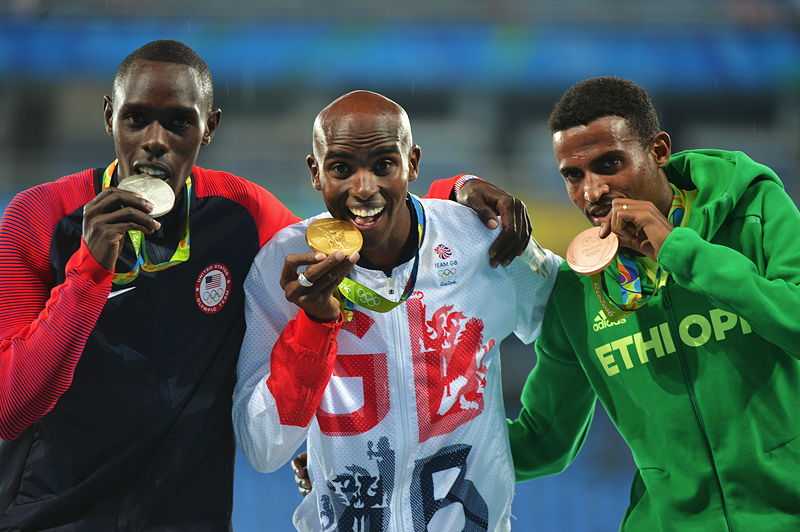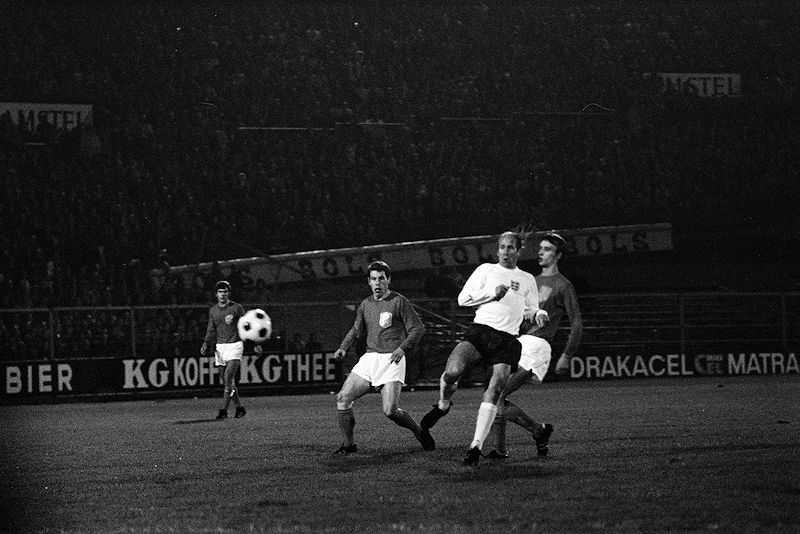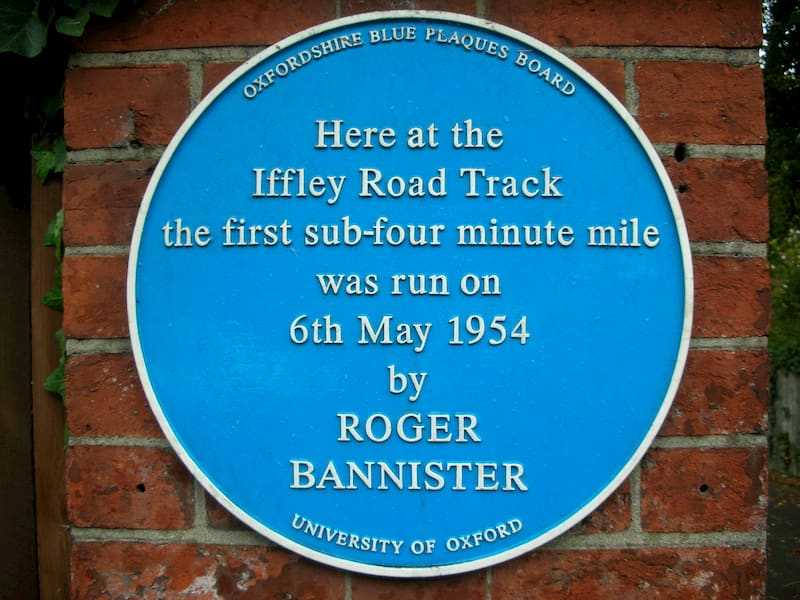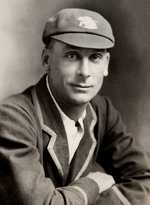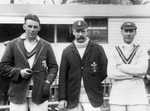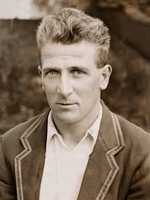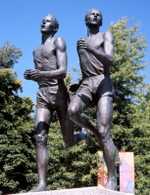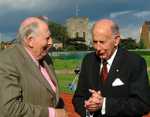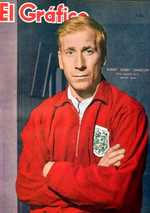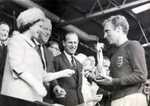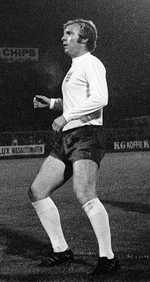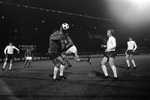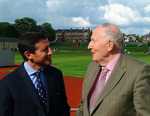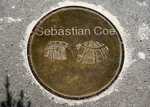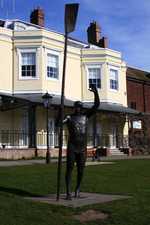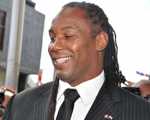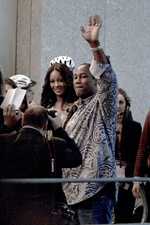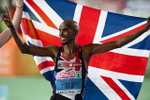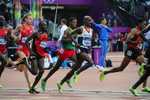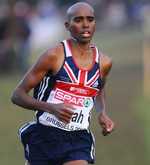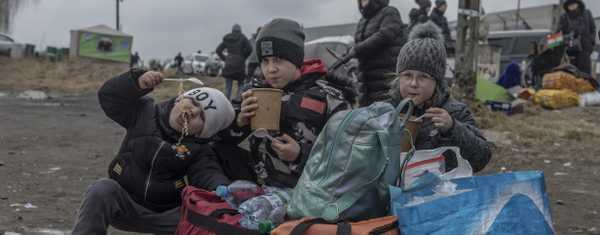1. Jack Hobbs (1882-1963) – Cricketer (batsman)
Jack Hobbs was born John Berry Hobbs to John Hobbs, a slater, and Flora Berry. He had eleven siblings and quit school at age thirteen and worked in menial jobs to help with the family’s expenses.
When his father died in 1902, he was able to assume his father’s job as a groundsman at Jesus College.
In 1905, he was opening batsman for Tom Hayward in Surrey. After a game against the Gentlemen of England, Essex, and a touring Australian team, Hobbs was awarded his county cap.
At the end of the1906 season, Hobbs had scored 2,135 runs and was second to Hayward, in Surrey average.
In 1908, Hobbs scored 876 runs against Tasmania and Victoria. In 1909, He and Wilfred Rhodes outsmarted the South African team who were googly bowlers and used matting wickets. Hobbs made 1,124 runs and earned the title World’s Leading Batsman.
During the 1911-1912 season, Hobbs’s aggregate score was 2,042 in tests against South Africa and Australia in the Triangular Tournament.
Hobbs served in the Royal Air Force in World War I. In 1923, he returned to cricket and scored his 100th century against Somerset.
Between 1924 and 1934, Hobbs broke several records; the England-Australian tests by Victor Trumper, the score runner record set by Clem Hill in 1912, and the first-class hundreds record set by W. C. Grace. He retired in 1935 and managed his sports shop.
Hobbs and his wife Ada were married for fifty-seven years and had four children. They both died in 1963, she in March and he in December.
2. Harold Larwood (1904-1995) – Cricketer (bowler)
Harold Larwood was born to Robert Larwood, a miner, and Mary Sharman. He dropped out of school when he was thirteen and worked at menial jobs.
In 1923, at age nineteen, Larwood did a trial run for the county’s Second XI against Lancashire. After taking 8 wickets for 44 runs, he was offered a contract. In 1924, against Northamptonshire, he had 26 overs and conceded 71 runs.
In 1926, Larwood helped England break its fourteen-year losing streak for The Ashes. He took 137 wickets at an 18.31 average. His batting score was 451 which earned him the title of One of the Five Wisden Cricketers of the Year.
During the 1927-1928 season, Larwood played in two tests against an emerging West Indies team. He took 138 wickets at an average of 14.51 and headed the national bowling averages. During that season, he also had his first century against Gloucestershire.
Larwood was part of the Australian Tour during the 1932-1933 season. Douglass Jardine, the coach, directed Larwood and the other ‘fast’ bowlers to concentrate the bowling attack at or near the batsman’s legs, in the hopes of cramping the batsman’s usual style (leg theory bowling). He also directed a variant of this bowling style to include a fast short-pitched ball that would rise into the batsman’s body. A Melbourne reporter criticized England’s tactics and coined the word “bodyline.” England won the five-test series, but several Australian players were badly hurt.
Larwood retired in 1938. He had an overall record of 1,427 wickets at 17.51, 7,290 runs at 19.91, and 3 centuries.
In 1995, Larwood died. He was married sixty-eight years to Lois Bird. They had five daughters.
3. Roger Gilbert Bannister (1929-2018) – Runner (Middle Distance)
Roger Gilbert Bannister was born to Ralph Bannister, a civil servant, and Alice Duckworth. Bannister won the Junior Cross-Country Cup three consecutive times in elementary school. In 1946, he enrolled at University College in Hempstead and Exeter College, Oxford.
In 1947, at Oxford, Bannister was selected as the third string for Oxford and ran the mile race against Cambridge at White City Stadium. He won the race by twenty yards in a time of 4 minutes and 30.8 seconds.
At the 1952 Olympics, Bannister set a British record for the 1500 metres race at 3 minutes and 46.30 seconds. He came in fourth, but he had an ‘aha’ moment. He realized the sub-4-minute mile was possible. On May 6, 1954, in a meet between British AAA and Oxford, he finished the mile race with a time of 3 minutes 57.9 seconds, beating Australian John Landy’s record of 3 minutes 59.4 seconds.
Three months later, Bannister competed in the British Empire and Commonwealth Games in Vancouver, B.C. against Landy in “The Miracle Mile” race. Bannister beat Landy with a time of 3 minutes 58.8 seconds.
In 1954, Bannister retired from athletics.
Bannister married Moyra Jacobsson in 1955. They have four children.
4. Bobby Charlton (1937-) – Football (Midfielder/Forward)
Bobby Charlton was born to Robert Charlton, a coal miner, and Elizabeth Milburn. At age sixteen, he left school and signed with the Manchester United team and became one of Matt Busby’s “Busby Babes”.
In the 1956-1957 season, Charlton debuted against the Charlton Athletics. He played fourteen times, scored twice, and managed twelve goals in all competitions, including a hat-trick to win 5-1 over Charlton.
In 1958, Charlton was part of the first English team to compete in the European Cup. While on their way to play the final leg of the competition, their airplane had a horrific crash in Munich. Eight of his team members died.
In 1963, Manchester United beat Leicester City 3-1 in a FA Cup. Charlton won a winner’s medal. In 1965 and 1967, Manchester United gained success and took titles. Charlton’s performance earned him the titles of Football Writers Association Footballer of the Year and European Footballer of the Year.
In 1968, at the European Cup Finals at Wemby, Charlton, team captain, scored twice and Manchester United won 4-1 over Benfica.
Charlton retired in 1973. He had scored 249 goals and set a club record of 758 appearances, 105 of them were international appearances.
Charlton married Norma Bell in 1961. They have two children.
5. Bobby Moore (1941-1993) – Football (Defender)
Robert Frederick Chelsea Moore was born to Robert Moore, a pipe lagger, and Doris Buckle. He was educated at Westbury Primary School and Tom Hood Technical High School in Leyton.
In 1959, Moore played in the FA Youth Cup and won 1-0 in the Southern Junior Floodlit Cup against Chelsea.
By 1962, during the Summers World Cup in Chili, Moore’s team, the England Under 23 squad, won 4-0 over Peru in Lima.
Moore became captain of his team in 1963. They won 4-2 against Czechoslovakia. In 1964, in the FA Cup, Moore’s team defeated Preston North End 3-2 at Wembly. Moore was named the Football Writers’ Association Footballer of the Year.
In 1966, Moore served as captain for England in the FIFA World Cup. After a successful run against Argentina and Portugal, Moore’s team faced Germany. Defeat seemed inevitable, but Moore came through in the final seconds and England won. Queen Elizabeth II presented the Jules Rimet trophy to Moore.
In Moore’s sixteen-year tenure with West Ham, he played in six hundred games and won 108 caps. He retired in 1973.
Moore married Christina Dean in 1962. They divorced in 1986 and he married Stephanie Parlane in 1991. They have two children.
6. Ian Botham (1955-) – Cricketer (All-Rounder)
Ian Terrence Botham was born to Herbert Botham, helicopter test engineer, and Violet Collett. Botham was a precocious child and developed an interest in cricket at age four. Botham left Bucklers Mead Comprehensive School at age sixteen and took a job with the ground staff at Lord’s Cricket Ground.
Debuting for Somerset in 1973, Botham played in a List-A John Player League (JPL) against Sussex. He scored 4 runs, took l wicket for 14 and held one catch.
In 1974, Botham played against Hampshire. He hit two sixes and made 45 enabling Somerset to win by one wicket. He won the Gold Award. In July of that year, he scored his first half century and made 59 against Middlesex. Somerset won by 73 runs.
In 1976, Botham scored over 1,000 runs for the first time, completed his first century, and earned selection by England to two Limited Overs Internationals.
By 1980, while in India, Botham became the first player in Test history to score a century and take 10 wickets in the same match. England won by 10 wickets.
Between 1981 and 1984, Botham played in 25 Tests, including India, Pakistan, and Sri Lanka. Botham was in 17 class matches and scored 1,241 runs with a highest of 208 against India.
Between 1987 and 1993, Botham played with Worcestershire, Queensland in Australia, and Durham.
Botham retired in 1993. He married Kathryn Waller in 1996. They have three children.
7. Sebastian Coe (1956-) – Runner (Middle Distance)
Sebastian Newbold Coe was born to Peter Coe, engineer, and Tina Lal. Coe grew up in Warwickshire and Sheffield and attended numerous schools, including Loughborough University.
In 1977, Coe won his first major middle-distance race. He ran the 800 metres event at the European Indoor Championship in San Sebastian, Spain.
In the 1978 and 1979 seasons, Coe won the 800 metres in Brussels with a time of 1:44.26, a UK national record. He also won the Longhrea 4-mile road race in Ireland with a time of 17:55.
In 1979, Coe set three world records in forty-one days: 800 metres in 1:42.33, mile in 3:48.95 in Oslo, Norway, and broke the world record of 1500 metres in 3:32.03 at Zurich, Switzerland. He was voted the “Athlete of the Year” by Athletics Weekly and Track and Field News.
In 1980, Coe won his first Gold Medal at the Moscow Olympics in the 1500 metres: running the last 400 metres in 52.2 and the last 100 metres in 12.1. In 1984, he won his second Gold Medal in the Olympc Games in Los Angeles in the 1500 metres race with a time of 3:32.53. He was the only person to win successive Olympic 1500 metres titles.
From 1986 to1989, he ran and won the 800 metres (Gold Medal in Stuttgart) and 1500 metres for the AAA title. He was ranked British Number One over the 800 and 1500 metres races.
Coe married Nicky McIrvine in 1990. They divorced in 2002. He married Carole Annett in 2011. They have four children.
8. Steve Redgrave (1962-) – Rower (Sweeper)
Steven Geoffrey Redgrave was born to Geoffrey Redgrave, builder, and Sheila Marion. At age sixteen, Redgrave rowed in competitions at his school, The Great Marlowe School, for the junior team in 1979 and the senior team in 1981.
From 1984 to 2000, he won five Olympic Gold Medals. In the Los Angeles Olympics in 1984, he rowed in a coxed four team.
In 1996, Redgrave and his rowing partner, Matthew Pinsent, won a Gold Medal in the Atlanta Olympics. It was the only Gold Medal achieved by the entire British Olympians.
Redgrave was seriously ill during a large portion of his career. In 2,000, he retired and was awarded the Gold Olympic pin by International Olympic President, Juan Antonio Samaranch.
Redgrave is married to Ann Calloway. They have three children.
9. Lennox Lewis (1965-) – Boxer
Lennox Claudius Lewis was born to Carlton brooks and Violet Lewis. At the age of twelve, Lewis moved to Kitchener, Ontario where he attended Cameron Heights Collegiate Institute.
Arnie Boehm encouraged Lewis to try boxing. Later, he became Lewis’s coach, friend, and father figure. At the age of fifteen, Lewis debuted in the Ontario Golden Gloves Championship in the 165-pound division and won. After that, he dropped his nickname, ‘Junior,’ and chose ‘Lennox.’
In 1983, Lewis won a Gold Medal in the World Junior Championship in Santa Domingo against Cuban Pedro Nemicio.
In the 1988 Summer Olympics in Seoul, Korea, Lewis defeated American Riddick Bowe and won a Gold Medal, the first Canadian to win boxing Gold since the 1932 Olympics.
In 1992, as a ‘Pro’, Lewis fought Donovan “Razor” Ruddock and defeated him after two rounds.
Between 1994 and 2002, Lewis had a series of bizarre experiences. In a fight with Oliver McCall, he was knocked down in round two and the referee stopped the fight. He attempted to get a rematch, but WBC officials denied the request. He was told he had to win a fight with Lionel Butler before getting a rematch with McCall.
Lewis fought and defeated Butler, but the WBC reneged on its promise. Instead, Mike Tyson was scheduled to fight McCall. Lewis sued. A supreme court judge ruled in Lewis’s favor. Lewis was offered four million dollars to step aside so that Mike Tyson could fight Bruce Seldon. Lewis accepted the money.
Tyson beat Seldon for the WBA title. He relinquished the title because he wanted to fight Evander Holyfield. This move allowed Lewis to fight for the vacated WBA title against Oliver McCall.
McCall had a drug problem which became apparent during his fight with Lewis. By the fifth round, the referee disqualified McCall and Lewis was declared the winner.
In March 1999, Lewis fought Holyfield. He lost. During a rematch in November 1999, he won. Lewis was named the Fighter of the Year by the Boxing Writers Association of America.
In 2002, Lewis fought Tyson, won in round eight, and was declared the heavyweight champion.
Lewis retired in 2004 with a record of 41 wins, 2 losses, 1 draw, and 32 wins by knockouts.
He married Violet Chang in 2005. They have four children.
Between 2008 and 2012, Lennox was inducted into several Halls of Fame: Canada, International Boxing, and Ontario Sports.
10. Mo Farah (1986-) – Runner (Long-Distance)
Mohammed Muktar Jama Farah was born to Muktar Farah, an IT Consultant, and Amran Farah. He was educated at Isleworth and Syon School and Feltham Community College.
In 2001, Farah ran the 5,000 metres race and won the European Athletics Junior Championship. In 2011, at the International Association of Athletics Federation (IAAF) in Taegu, South Korea, Farah won the 5,000 metres title.
In 2012 and 2016, at the London and Rio de Janeiro Olympic games, Farah took dual Gold Medals in the 5,000 and 10,000 metres. He became the second man to win those races in two consecutive Olympics.
In 2018, Farah entered the Chicago Marathon. He set a new European record of 2 hours, 5 minutes, and 11 seconds and claimed the Gold Medal.
Farah married Tania Nell in 2010. They have four children. He retired in 2020.
